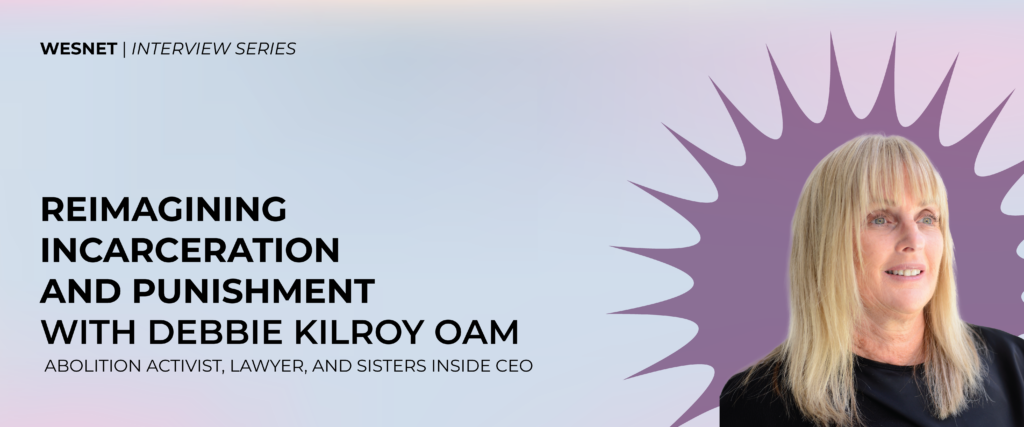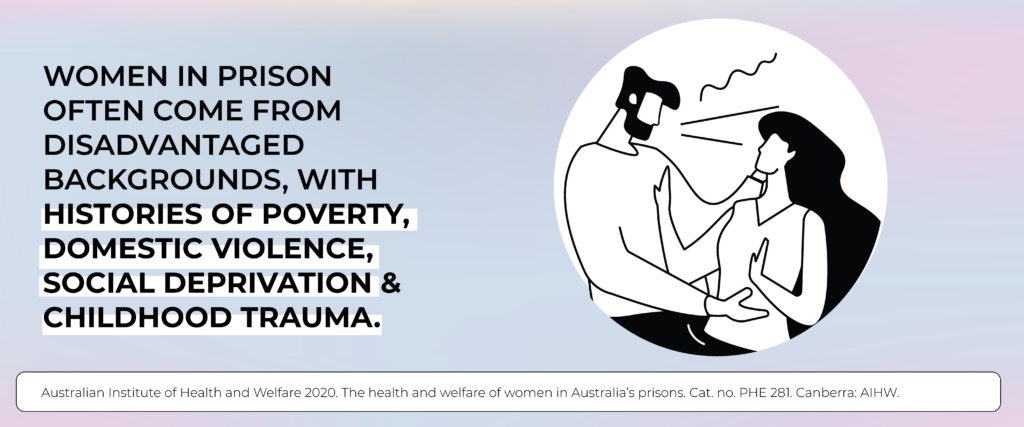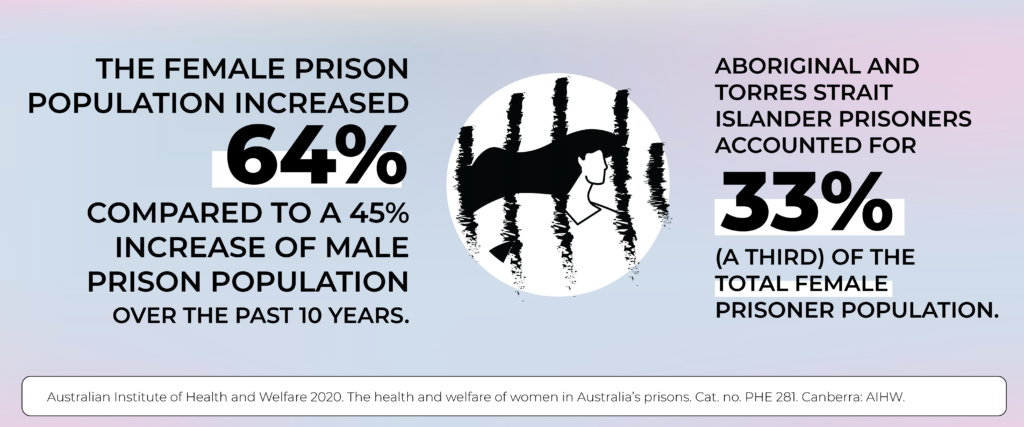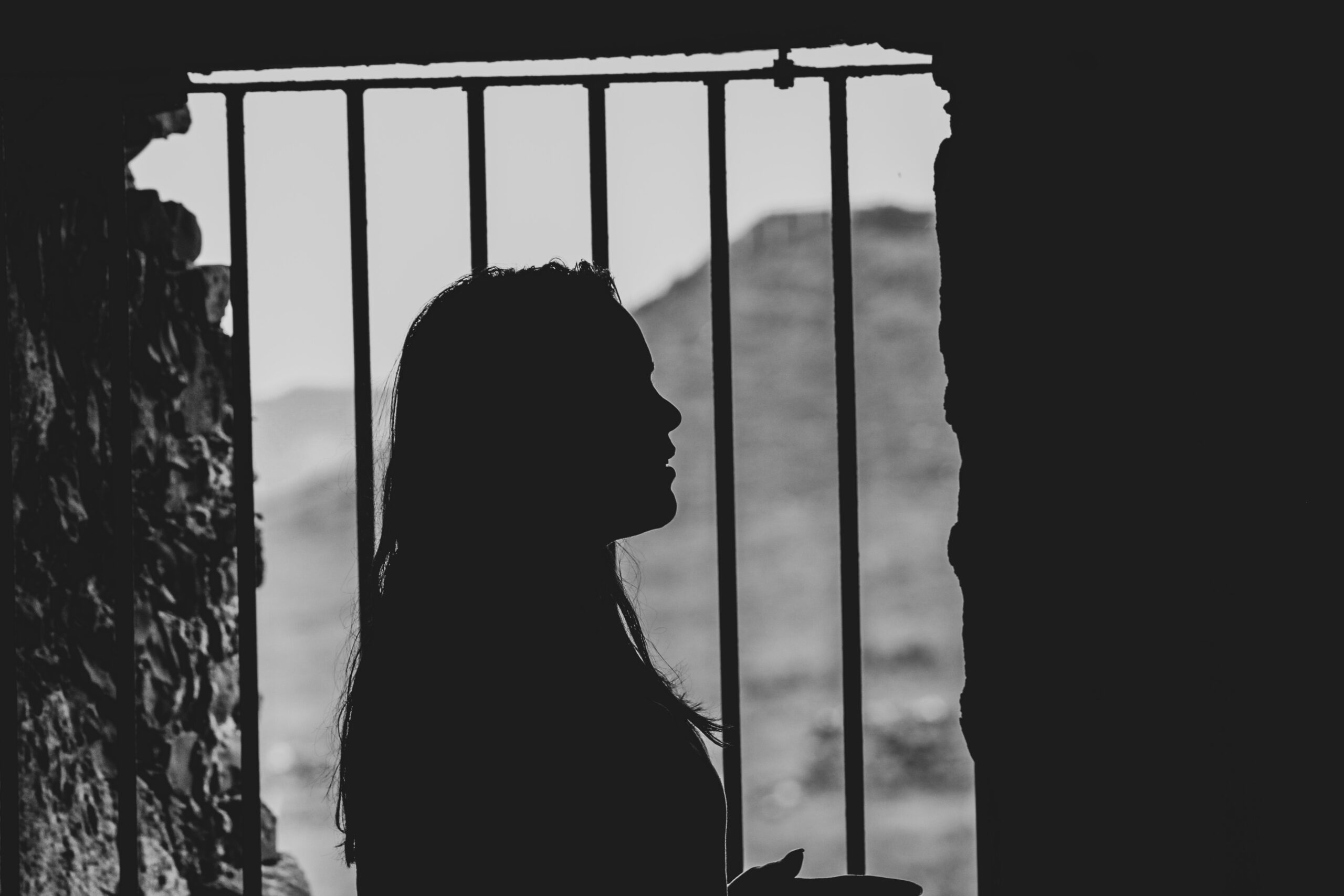WESNET INTERVIEW SERIES
The number of women being incarcerated in Australia has been exponentially increasing in the last decade, with Aboriginal and Torres Strait Islander women accounting for much of the growth.
Consider this, between 2009 and 2019, there was a 64% increase in women’s incarceration compared to a 45% increase in men’s incarceration. And even during the lockdowns, back in 2020 and 2021, there was a 5% increase in the female population, with Aboriginal and Torres Strait Islander women comprising 10% of the total female prison population.
Moreover, evidence suggests that an overwhelming majority of women in prison are victims of domestic violence, with 70-90% of them experiencing some kind of physical, sexual, or emotional abuse as children or adults.
But what is this data telling us? The reality is that this increase in women’s incarceration disproportionately affects women affected by experiences of oppression and victimisation and that come from the most marginalised communities in Australia. And it is also a stark reflection about “the nature and proliferation of gender-based violence in this country.”
We talked with Debbie Kilroy, OAM, abolition activist, lawyer, and CEO of Sisters Inside, about the importance of including lived experience perspectives and voices – especially in any work related to the criminalised community; how the criminalised community is being actively discriminated against when advocating for their rights; how the intersecting oppressions feeds the incarceration cycle of women and how the women’s specialist services could do more. And lastly, Debbie invites us all in reimagining the carceral system of punishment and incarceration and advocate for a future focused on healing and love instead.

1. Debbie, thank you for joining us. We are honoured to have you here. For those reading who don’t know you, could you tell us a bit about yourself and how you came to be an advocate for the rights of women in prison?
Thank you for having me here.
I am an abolition activist, a lawyer and CEO of Sisters Inside (an abolitionist organization which advocates for the collective human rights of women and girls and feminine identifying people in prison, and their families).
I came to this work because of my own lived prison experience, and everything that I saw while inside and what I experienced while trying to break free from the criminal injustice system. I was criminalised as a young child and first imprisoned at 14 years of age. I spent my subsequent teenage years in and out of prison. Then, in 1989, I was sentenced to 6 years imprisonment for drug trafficking. It was while I was inside that I witnessed my friend, Debbie Dick, being murdered in the overcrowded prison, Boggo Road Gaol.
With everything that I saw inside, I grew angrier and angrier – I was angry at the gross injustice, and that anger ultimately became a productive force as it spurred a commitment and drive in me to fight against the criminalisation and imprisonment of women. This drive of mine and the work I came to do was partly to honour my friend, Debbie, but also to honour every woman and girl who had suffered and/or died at the hands of the prison industrial complex.
I saw prisons as needless places of suffering, and as places of violence, I resolved to do something about that. Prisons steal from all of us, and they stole more than just time from me. I lost everything when I went inside – my marriage, my home, my kids and my job. I don’t want them to take anything else from anyone else.
2. With you having been intimately and uniquely involved in the prison and judicial system from a variety of perspectives, how important is lived experience to the work of an advocate/activist? How can governments and the community better involve ex-prisoners in service delivery and system reform?
I would argue that there is no greater importance or relevance than that of the lived experience perspective, particularly in relation to work with the criminalised community. The adage ‘there should be nothing about us, without us’ isn’t just a saying, it is an ethos that we all should live by.
If you are sitting around the table discussing a particular group of people and you look around and see that that group is not represented at that table, discussions should cease until appropriate representation is found.
How can you possibly understand the needs of a population group if you are not them? How can you make decisions for that group of people? How can you design services or know their needs? Unless you know that oppression intimately, you are not the expert, no matter your degree of knowledge or your proximity to that person or population group. You will never truly know. However, the lived prison experience activist is often ignored in this country.
We witness panels and conversations being held right across the nation which do not include our voices.
Policies are written, services designed, and programs developed, which do not include our voices or our experiences. They do not reflect our aspirations or our vision for our needs or healing. Largely, that is because the criminalised community are regarded as a group who are not worthy of consultation, we are a group that is pathologized as the problem to be fixed, and others are deemed to know better than we do. Add to that, there is an inherent risk to us when we do speak out or up about services or systems. A risk to our liberty. Therefore, organisations that want to involve the lived prison activist or advocate in their work need to be mindful of that risk and wear it themselves. They must ensure that meetings and spaces are safe for the criminalised participant.
For example, one of the women in our National Network commented this week that she wanted to attend the local community consultation on the Disability Royal Commission with the Community Indigenous Advocate in her regional town. However, that meeting was being held at a licenced club venue. As this member is on parole, she was unable to attend as all people on parole are unable to attend licenced club venues. Therefore, this community consultation specifically and actively excludes the criminalised community – and our needs remain unaddressed, unheard, not considered and invisibilized through agency ignorance (startling given the high rate of disabled people who are criminalised). This kind of thing happens all the time, and it’s not good enough.
3. Some people’s experiences of prison life are limited to what they read or see in the media. Are these accurate representations? Are there key issues for women that are not openly talked about or understood?
It’s funny because what you see and hear about jails would lead you to think that the biggest thing you have to fear in prison is other prisoners. But what I would argue is the biggest risk to your life and wellbeing is the carceral system itself and the State agents which are paid to enforce the regime with both force and impunity. Though what I just said is an unpopular thing in our society to speak and hear.
We are taught from a young age that the “crims” are the “baddies”, and the police are the “goodies”.
It is this good/bad binary that leads us to believe that one group of people deserve more humanity than the other. It’s just unsustainable and doesn’t create a safe and abundant community for all, only some.
The key issue for women is definitely the increasing criminalisation of us – it is at this apex that we find our oppression. Women, and specifically Aboriginal and Torres Strait Islander women, are the fastest growing prison cohort in this country. Nationally, the proportion of women in the Australian prison population rose 5 per cent between 2020 and 2021, and Aboriginal and Torres Strait Islander women comprised 10 per cent of the prison population. The situation is unconscionable.
Most distressing is the system’s persistent criminalisation of Aboriginal and Torres Strait Islander people and the resulting deaths in custody. The figure presently sits at 505 people killed in custody since 1991, and that figure grows every single month. We should all be angry. But some of you aren’t, and I don’t understand that.
4. According to data released from the ABS in 2018, an overwhelming majority of women in prison have experienced domestic violence, with data suggesting that between 70% to 90% of incarcerated women have been physically, sexually or emotionally abused as children or adults. Based on this, would you say that family violence ‘seem to be’ a pathway to offending?
I wouldn’t say that family violence is a pathway to offending. Rather, I would say that women in this country are criminalised. Intersecting oppressions render women particularly vulnerable to obtrusion by the state, and many women at a very young age are set upon a trajectory of state-sanctioned interventions and ultimately incarceration.
Women and girls defending themselves against violence often become the targets of law enforcement – a phenomenon which is increasingly being referred to as the sexual abuse to prison pipeline.
Additionally, the statistics presented above are reflective of the nature and proliferation of gender-based violence in this country rather than a reflection of the “type of woman” that finds herself in prison. As reflected in other countries, incarcerated women and girls come from the most disadvantaged backgrounds and represent the most socially, culturally, and economically marginalised people in Australia.
There is a growing mountain of evidence which speaks to the trauma women have suffered prior to their incarceration, with a majority suffering from a range of gender-based violence, including poverty, housing instability, homelessness, domestic violence, child abuse, poor health, trauma and both surveillance and control by the state, because we have a violence problem in this country. And until we reckon with that fact, we will not truly be able to address it fully.

5. Are incarcerated women more vulnerable during their stay in prison or after release? How can women specialist services better support women in prison or that have been in prison? [Or] What should the role of women specialist services in supporting women in prison be?
Incarcerated women and girls are vulnerable through the entire carceral pipeline. Once the state has their eyes set on you, you are marked, therefore, at risk. Incarcerated women are almost completely powerless while in prison, relying on the state to meet their every basic need. Then, when they are released, they have to start their lives all over again, with very little to no support, under the constant gaze of the State.
Economic violence against criminalised women exists before, during and after our imprisonment.
Add to that, over the past two decades, the real value of income support and the quantum of public housing in Australia has reduced substantially, and the cost of public transport and other essentials has increased exponentially. Most criminalised women live far below the poverty line, while at the same time, systems of surveillance and imprisonment seem to have access to a bottomless pit of government funding, resulting in a gross economic divide.
Economically, it is almost impossible for women to meet the demands of income support, parole and child protection authorities. Yet, the system demands that women conform to the mostly irrational demands of these authorities to stay out of prison, retain or regain custody of their children and meet the basic survival needs of themselves and their children despite economic disadvantage. This system is constructed in a way to ensure that women fail.
What we need from specialist services is to do the two-pronged work of supporting women who are held captive by the carceral system while you are standing with us to actively tear apart the prison industrial system.
Too many services only want to do the work of support. It’s not enough, and it is, in my view, unethical and most certainly contributes to the prison industrial complex, making you complicit in the carceral structures. We need non-criminalised people to weaponise their privilege, and that need is most urgent.
Right now, we have a prison in Victoria being expanded. We have children in Dondale. We have children being placed in solitary in adult prisons. Silence from support services is deafening and, worse, harmful. We need you to be activists, too.
6. Covid-19 has had wide ranging impacts. We know from global data that lockdowns across the world increased not only the incidence of domestic and family violence but also catalysed violence for the first time in thousands of homes. What was the impact of COVID for women in prisons?
We know that everyone in prison suffered and continues to. COVID-19 functioned as an excuse for prisons to further punish prisoners at a systemic level. The use of seclusion, isolation and lockdowns to reduce the risk of transmission of the disease, as well as the failure of many prisons to provide free access to soap, running water, and hand sanitiser, impacted the health and wellbeing of all prisoners inside.
Added to that, visits ceased or were seriously disrupted, meaning that mothers and children were unable to have visits for months on end. Little to no practical support was provided to the parents to maintain contact with their children, and the mental health and well-being of both parent and child have and continues to suffer. The National Network for Incarcerated and Formerly Incarcerated Women and Girls (NNIFIWG) called for the freeing of all prisoners and maintains that call. Nobody should be in prison, and a global pandemic was a good time for the government to commence a decarceration process before someone died.
7. Do you feel that the second National Plan to End Violence Against Women and Children will assist women in prison?
The National plan makes a small mention of women in prison, so I would say it falls well short of articulating an evidence-based or expert-informed plan or strategy to ensure that women and girls who are in or have been to prison will be able to live a life free from violence – personal, family or state abuse – in this country.
If we are going to work towards eliminating the kinds of violence that criminalised women and girls face, we must work to address the ongoing impacts of colonisation and state violence and transform the social, political and economic factors that continue to criminalise our sisters. We need substantial policy action to rectify structural barriers to safety and equality and an abolitionist framework to guide the National Plan. We do not see this, so I would say the National Plan will fail the women I am working for and alongside.

8. You talk openly about the need to abolish prisons and the need for new models that are not based on punishment and incarceration. In your ideal world, with no prisons, what would support and rehabilitation look like broadly?
I am often asked what new models I would like to see introduced in a new world free of prisons, and to be honest, it’s not my place to be prescriptive about what those new worlds look like.
I know this answer frustrates some people, but right now, our current system isn’t solving all our problems, and nobody has all the answers, so it’s unfair for abolitionists to be expected to.
The beautiful thing about abolition is that it creates a space for us to dream collectively about what that future will look and feel like.
It gives us the opportunity to work to change the conditions which produce harm and people who harm, so we don’t need systems of punishment and exile. Abolition also allows us to develop and design systems and services, and spaces that reflect individual community needs and aspirations, and it allows us to take a more nuanced view of the world. It removes the one size fits all approach to service provision and invests in the unique needs of local communities because if we persist in trying to reform this system which serves only the interests of private property and capital while enacting extreme violence, we will not realise safety for all. Ultimately, abolition is about recognizing the complexity of harm and the indispensability of humanity.
What I can say, though, is that a world free of prisons, punishment, surveillance, and exile will be a future that focuses on abundance and healing rather than scarcity and harm.
It will be a world focused on safety for all rather than revenge and vengeance. This process is going to be incredibly slow going and hard work as we seek to undo systems we have come to rely upon and unlearn processes we have internalised our whole lives – but it is necessary work, because abolition has the capacity to change the face of justice in this country and deliver love, safety and real liberty for all, not just the select few that this colony deems worthy. Abolition gives us life. It gives us a future.
We must start by shifting funds away from policing and prisons. It is why activist campaigns like “Build homes, not prisons” and “Close Dondale” are so important right now, as well as mutual aid campaigns like Disability Justice Australia and #FreeHer, and community-based initiatives like “Beyond Bricks and Bars”.
Locally led initiatives are moving us along the path to abolition because our emancipation will not be found in the halls of parliament or boardrooms, it will come in the streets and in our communities, led by the people. We just have to find our power.
9. And lastly, what are the main changes you are hoping to see in the future that will advance the rights of women in prison? And what are Sisters Inside’s immediate priorities over the next twelve months?
My priority is to continue to speak about abolition and encourage people to see it as the common-sense option for a safer future. I am an activist, so my work is in the struggle for freedom for all of my sisters, and my work will not be done until everyone is free.
In the meantime, Sisters Inside will keep working to free women and girls from State cages and will grow a Network of incarcerated and formerly incarcerated women and girls and feminine identifying people to make sure that the voices of criminalised people are present in all public spaces, and that we are able to have a real say in the political landscape of this country, because there should be nothing about us, without us.
—
About the series: The WESNET Interview Series brings an array of diverse opinions, perspectives and insights from different professionals, practitioners, experts, and advocates on violence against women and girls and other forms of gender-based violence. We aim to share the full diversity of voices to help inform and expand the narratives around ending violence in all its forms. Not all the voices will agree on every aspect of what to do and how to do it, but all the voices are from those committed to ending gender-based violence. You can read the rest of our interviews here.
